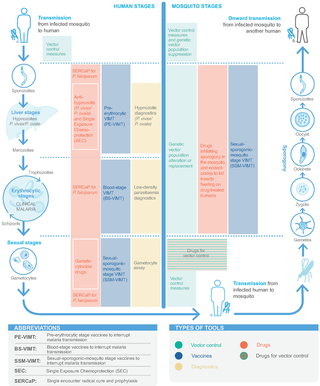Our official English website, www.x-mol.net, welcomes your
feedback! (Note: you will need to create a separate account there.)
malERA: An updated research agenda for diagnostics, drugs, vaccines, and vector control in malaria elimination and eradication.
PLOS Medicine ( IF 10.5 ) Pub Date : 2017-11-30 , DOI: 10.1371/journal.pmed.1002455
PLOS Medicine ( IF 10.5 ) Pub Date : 2017-11-30 , DOI: 10.1371/journal.pmed.1002455

|
Since the turn of the century, a remarkable expansion has been achieved in the range and effectiveness of products and strategies available to prevent, treat, and control malaria, including advances in diagnostics, drugs, vaccines, and vector control. These advances have once again put malaria elimination on the agenda. However, it is clear that even with the means available today, malaria control and elimination pose a formidable challenge in many settings. Thus, currently available resources must be used more effectively, and new products and approaches likely to achieve these goals must be developed. This paper considers tools (both those available and others that may be required) to achieve and maintain malaria elimination. New diagnostics are needed to direct treatment and detect transmission potential; new drugs and vaccines to overcome existing resistance and protect against clinical and severe disease, as well as block transmission and prevent relapses; and new vector control measures to overcome insecticide resistance and more powerfully interrupt transmission. It is also essential that strategies for combining new and existing approaches are developed for different settings to maximise their longevity and effectiveness in areas with continuing transmission and receptivity. For areas where local elimination has been recently achieved, understanding which measures are needed to maintain elimination is necessary to prevent rebound and the reestablishment of transmission. This becomes increasingly important as more countries move towards elimination.
中文翻译:

malERA:关于消除和消除疟疾的诊断,药物,疫苗和媒介控制的最新研究议程。
自本世纪初以来,可用于预防,治疗和控制疟疾的产品和策略的范围和有效性取得了显着的扩展,包括诊断,药物,疫苗和载体控制方面的进步。这些进步再次将消除疟疾列入议程。但是,很显然,即使采用当今可用的手段,在许多情况下,控制和消除疟疾也构成了巨大的挑战。因此,必须更有效地利用当前可用的资源,并且必须开发可能实现这些目标的新产品和方法。本文考虑了实现和维持消除疟疾的工具(包括可用的工具和可能需要的其他工具)。需要新的诊断方法来指导治疗并检测传播潜能。新药和疫苗,以克服现有的耐药性并保护其免受临床和严重疾病的侵害,并阻止传播并防止复发;以及新的病媒控制措施,以克服对杀虫剂的抗性并更有效地中断传播。同样重要的是,要针对不同的环境制定将新方法与现有方法相结合的策略,以在持续传播和接受的地区最大化其寿命和有效性。对于最近已实现局部消除的地区,有必要了解需要采取哪些措施来保持消除,以防止反弹和传播的重新建立。随着越来越多的国家走向消灭,这一点变得越来越重要。以及阻止传播并防止复发;以及新的病媒控制措施,以克服对杀虫剂的抗性并更有效地中断传播。同样重要的是,要针对不同的环境制定出将新方法与现有方法相结合的策略,以在持续传播和接受的地区最大化其寿命和有效性。对于最近已实现局部消除的地区,有必要了解需要采取哪些措施来保持消除,以防止反弹和传播的重新建立。随着越来越多的国家走向消灭,这一点变得越来越重要。以及阻止传播并防止复发;以及新的病媒控制措施,以克服对杀虫剂的抗性并更有效地中断传播。同样重要的是,要针对不同的环境制定将新方法与现有方法相结合的策略,以在持续传播和接受的地区最大限度地延长其寿命和有效性。对于最近已实现局部消除的地区,有必要了解需要采取哪些措施来保持消除,以防止反弹和传播的重新建立。随着越来越多的国家走向消灭,这一点变得越来越重要。同样重要的是,要针对不同的环境制定将新方法与现有方法相结合的策略,以在持续传播和接受的地区最大化其寿命和有效性。对于最近已实现局部消除的地区,有必要了解需要采取哪些措施来保持消除,以防止反弹和传播的重新建立。随着越来越多的国家走向消灭,这一点变得越来越重要。同样重要的是,要针对不同的环境制定出将新方法与现有方法相结合的策略,以在持续传播和接受的地区最大化其寿命和有效性。对于最近已实现局部消除的地区,有必要了解需要采取哪些措施来保持消除,以防止反弹和传播的重新建立。随着越来越多的国家走向消除,这一点变得越来越重要。
更新日期:2017-12-01
中文翻译:

malERA:关于消除和消除疟疾的诊断,药物,疫苗和媒介控制的最新研究议程。
自本世纪初以来,可用于预防,治疗和控制疟疾的产品和策略的范围和有效性取得了显着的扩展,包括诊断,药物,疫苗和载体控制方面的进步。这些进步再次将消除疟疾列入议程。但是,很显然,即使采用当今可用的手段,在许多情况下,控制和消除疟疾也构成了巨大的挑战。因此,必须更有效地利用当前可用的资源,并且必须开发可能实现这些目标的新产品和方法。本文考虑了实现和维持消除疟疾的工具(包括可用的工具和可能需要的其他工具)。需要新的诊断方法来指导治疗并检测传播潜能。新药和疫苗,以克服现有的耐药性并保护其免受临床和严重疾病的侵害,并阻止传播并防止复发;以及新的病媒控制措施,以克服对杀虫剂的抗性并更有效地中断传播。同样重要的是,要针对不同的环境制定将新方法与现有方法相结合的策略,以在持续传播和接受的地区最大化其寿命和有效性。对于最近已实现局部消除的地区,有必要了解需要采取哪些措施来保持消除,以防止反弹和传播的重新建立。随着越来越多的国家走向消灭,这一点变得越来越重要。以及阻止传播并防止复发;以及新的病媒控制措施,以克服对杀虫剂的抗性并更有效地中断传播。同样重要的是,要针对不同的环境制定出将新方法与现有方法相结合的策略,以在持续传播和接受的地区最大化其寿命和有效性。对于最近已实现局部消除的地区,有必要了解需要采取哪些措施来保持消除,以防止反弹和传播的重新建立。随着越来越多的国家走向消灭,这一点变得越来越重要。以及阻止传播并防止复发;以及新的病媒控制措施,以克服对杀虫剂的抗性并更有效地中断传播。同样重要的是,要针对不同的环境制定将新方法与现有方法相结合的策略,以在持续传播和接受的地区最大限度地延长其寿命和有效性。对于最近已实现局部消除的地区,有必要了解需要采取哪些措施来保持消除,以防止反弹和传播的重新建立。随着越来越多的国家走向消灭,这一点变得越来越重要。同样重要的是,要针对不同的环境制定将新方法与现有方法相结合的策略,以在持续传播和接受的地区最大化其寿命和有效性。对于最近已实现局部消除的地区,有必要了解需要采取哪些措施来保持消除,以防止反弹和传播的重新建立。随着越来越多的国家走向消灭,这一点变得越来越重要。同样重要的是,要针对不同的环境制定出将新方法与现有方法相结合的策略,以在持续传播和接受的地区最大化其寿命和有效性。对于最近已实现局部消除的地区,有必要了解需要采取哪些措施来保持消除,以防止反弹和传播的重新建立。随着越来越多的国家走向消除,这一点变得越来越重要。











































 京公网安备 11010802027423号
京公网安备 11010802027423号